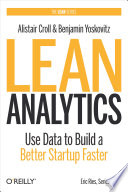

Lean Analytics emphasizes the importance of using data to inform decisions rather than relying on intuition or assumptions. This approach encourages businesses to collect relevant metrics that can guide their strategies and operational choices. By focusing on data, companies can identify trends, measure performance against goals, and make informed adjustments to their products or services. This shift towards data-driven decision-making is critical for startups and established companies alike, as it allows them to adapt to changing market conditions and customer needs. The book provides frameworks for identifying key performance indicators (KPIs) that matter most to the business's current stage, whether it be product development, customer acquisition, or scaling operations. As businesses grow, the type of data they need to focus on will change, and Lean Analytics provides a roadmap for navigating this evolution.
Continue readingOne of the core principles of Lean Analytics is the idea of focus. In the early stages of a startup, it can be tempting to chase multiple opportunities and metrics simultaneously. However, this can lead to confusion and diluted efforts. The book advocates for identifying a single metric that serves as the focal point for the business at any given time. This metric, often referred to as the 'One Metric That Matters' (OMTM), should align with the company's current goals and stage of development. By concentrating on one key metric, teams can streamline their efforts, make more significant progress, and avoid the pitfalls of trying to monitor too many indicators at once. This focus allows teams to pivot quickly if the data suggests that a change in strategy is necessary.
Continue readingLean Analytics is built around a framework that categorizes businesses into five stages: Empathy, Stickiness, Virality, Revenue, and Scale. Each stage has its own set of metrics that are most relevant for assessing performance and guiding decisions. For instance, during the Empathy stage, the focus is on understanding customer problems and validating product-market fit through metrics like customer feedback and engagement levels. As the business progresses, the focus shifts to stickiness (retention metrics), virality (growth metrics), revenue (monetization metrics), and finally to scaling operations efficiently. This structured approach helps entrepreneurs and managers understand where they are in their business journey and what metrics they should prioritize to drive growth and success.
Continue readingLean Analytics stresses the importance of balancing qualitative and quantitative metrics. While quantitative data provides hard numbers that can be analyzed statistically, qualitative data offers insights into customer feelings, motivations, and experiences. The book encourages businesses to not only look at the numbers but also to gather qualitative feedback through methods like interviews, surveys, and user testing. This combination allows for a more comprehensive understanding of customer needs and preferences, leading to better product development and marketing strategies. By integrating both types of metrics, businesses can create a more holistic view of their performance and customer satisfaction.
Continue readingAnother key idea in Lean Analytics is the role of experimentation in the business process. The book advocates for a culture of testing hypotheses through controlled experiments to validate assumptions about products, markets, and customer behaviors. This approach aligns with Lean Startup principles, where building, measuring, and learning are continuous processes. By conducting experiments, businesses can gather data that helps them understand what works and what doesn’t, allowing for more informed decision-making. Lean Analytics provides guidance on how to design effective experiments, interpret results, and pivot or persevere based on data-driven insights.
Continue readingEffective data visualization is crucial for interpreting and communicating data insights. Lean Analytics emphasizes the need for clear and impactful visual representations of data to facilitate understanding among team members and stakeholders. The book discusses various tools and techniques for creating dashboards and visual reports that highlight key metrics and trends. Good visualization helps to simplify complex data sets, making it easier to identify patterns, anomalies, and actionable insights. By presenting data visually, businesses can foster a data-driven culture where everyone in the organization can engage with metrics and contribute to decision-making.
Continue readingLean Analytics promotes the idea of iterative improvement, where businesses continuously refine their products, services, and strategies based on data feedback. This process involves regularly reviewing metrics, assessing performance, and implementing changes to enhance outcomes. The book encourages a mindset of agility and responsiveness, where teams are not afraid to make adjustments based on what the data reveals. This iterative approach is essential for staying competitive in fast-paced markets, as it enables businesses to respond quickly to customer feedback and market changes, ensuring that they remain relevant and effective.
Continue reading